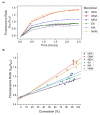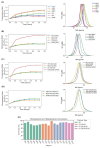A fully automated platform for photoinitiated RAFT polymerization
- PMID: 39650094
- PMCID: PMC7616994
- DOI: 10.1039/D2DD00100D
A fully automated platform for photoinitiated RAFT polymerization
Abstract
Oxygen tolerant polymerizations including Photoinduced Electron/Energy Transfer-Reversible Addition-Fragmentation Chain-Transfer (PET-RAFT) polymerization allow for high-throughput synthesis of diverse polymer architectures on the benchtop in parallel. Recent developments have further increased throughput using liquid handling robotics to automate reagent handling and dispensing into well plates thus enabling the combinatorial synthesis of large polymer libraries. Although liquid handling robotics can enable automated polymer reagent dispensing in well plates, photoinitiation and reaction monitoring require automation to provide a platform that enables the reliable and robust synthesis of various polymer compositions in high-throughput where polymers with desired molecular weights and low dispersity are obtained. Here, we describe the development of a robotic platform to fully automate PETRAFT polymerizations and provide individual control of reactions performed in well plates. On our platform, reagents are automatically dispensed in well plates, photoinitiated in individual wells with a custom-designed lightbox until the polymerizations are complete, and monitored online in real-time by tracking fluorescence intensities on a fluorescence plate reader, with well plate transfers between instruments occurring via a robotic arm. We found that this platform enabled robust parallel polymer synthesis of both acrylate and acrylamide homopolymers and copolymers, with high monomer conversions and low dispersity. The successful polymerizations obtained on this platform make it an efficient tool for combinatorial polymer chemistry. In addition, with the inclusion of machine learning protocols to help navigate the polymer space towards specific properties of interest, this robotic platform can ultimately become a self-driving lab that can dispense, synthesize, and monitor large polymer libraries.
Conflict of interest statement
Conflicts of interest The authors declare no conflict of interest.
Figures







References
-
- Fairbanks BD, Gunatillake PA, Meagher L. Biomedical applications of polymers derived by reversible addition-fragmentation chain-transfer (RAFT) Adv Drug Delivery Rev. 2015;91:141–152. - PubMed
-
- Nettekoven M, Thomas AW. Accelerating drug discovery by integrative implementation of laboratory automation in the work flow. Curr Med Chem. 2002;9(23):2179–2190. - PubMed
Grants and funding
LinkOut - more resources
Full Text Sources
Miscellaneous
